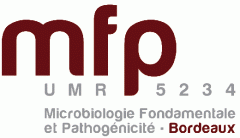 In addition to the “protein level”, specific nucleic acid structures of the viral genome can regulate viral replication. G-quadruplex nucleic acids (or “G4s”) are unusual DNA or RNA structures consisting in the stacking of planar arrangements of 4 guanines (G-tetrads). In a previous work, we identified G-rich aptamers as potent inhibitors of HIV-1 IN and RNase H (Métifiot M et al. Oligonucleotides. 2007 PMID:17638520) using a SELEX approach. The G4-forming aptamer 93del has been particularly studied and its mechanism of action investigated (Faure-Perraud A et al. Antivir Ther. 2011 PMID:21555821). Our work suggests that enzymes from the polynucleotidyl transferase family may have affinity for G quartet structures (Phan AT et al. Proc Natl Acad Sci U S A. 2005 PMID:15637158).
In addition to the “protein level”, specific nucleic acid structures of the viral genome can regulate viral replication. G-quadruplex nucleic acids (or “G4s”) are unusual DNA or RNA structures consisting in the stacking of planar arrangements of 4 guanines (G-tetrads). In a previous work, we identified G-rich aptamers as potent inhibitors of HIV-1 IN and RNase H (Métifiot M et al. Oligonucleotides. 2007 PMID:17638520) using a SELEX approach. The G4-forming aptamer 93del has been particularly studied and its mechanism of action investigated (Faure-Perraud A et al. Antivir Ther. 2011 PMID:21555821). Our work suggests that enzymes from the polynucleotidyl transferase family may have affinity for G quartet structures (Phan AT et al. Proc Natl Acad Sci U S A. 2005 PMID:15637158).
An increasing number of investigations demonstrates the involvement of these nucleic acid “knots” in key biological processes, including viral replication (Métifiot M et al. Nucleic Acids Res. 2014 PMID:25332402; Jaubert C et al. Sci Rep. 2018 PMID:29802381). Bioinformatics performed on alignment of more than 2000 HIV genome sequences (G4Hunter) showed that G-rich conserved sequences in the HIV-1 genome are capable of forming G-quadruplexes in both RNA and DNA forms [collaboration with the ARNA laboratory ()]. We focused on conserved G-rich regions that regulate HIV-1 promoter activity and overlap the SP1 and NFkB binding sites and investigated whether these viral G4 forming sequences actually form G4 DNA and/or RNA structures during the process of HIV-1 infection. In addition, we developed G4 ligands (collaboration with G Pratviel Toulouse) and used them as tools to understand how these structures regulate viral replication. G4 ligands inhibit HIV replication in human cells and quantification of viral nucleic acids by specific RT-qPCR and qPCR determined that they inhibit at an early step (post entry but before full reverse transcription). This suggests that G4 structures may regulate HIV-1 replication by recruiting viral enzymes and/or cellular partners at the RNA level (Amrane S et al. Nucleic Acids Res. 2022 PMID:36453997).
